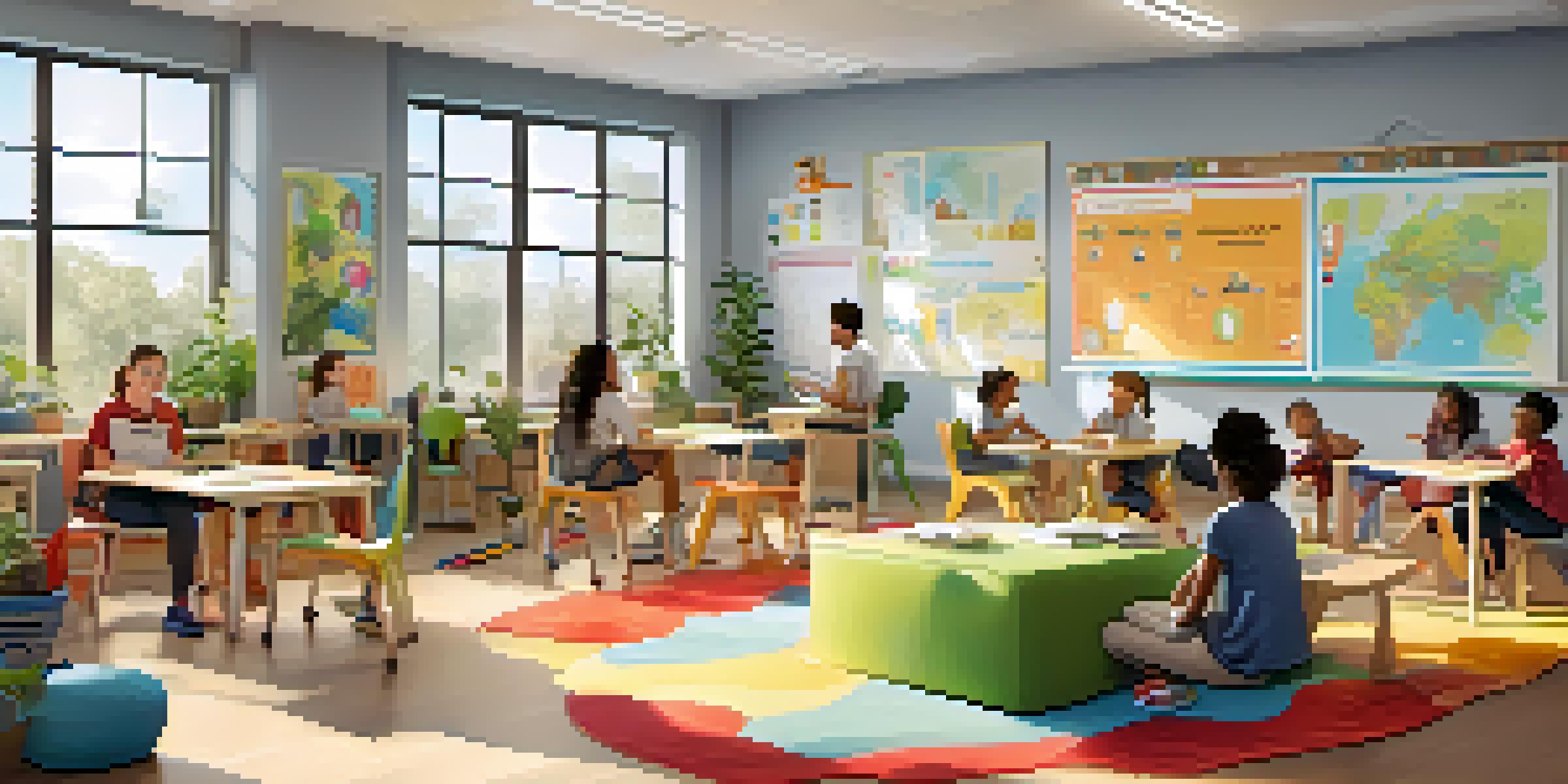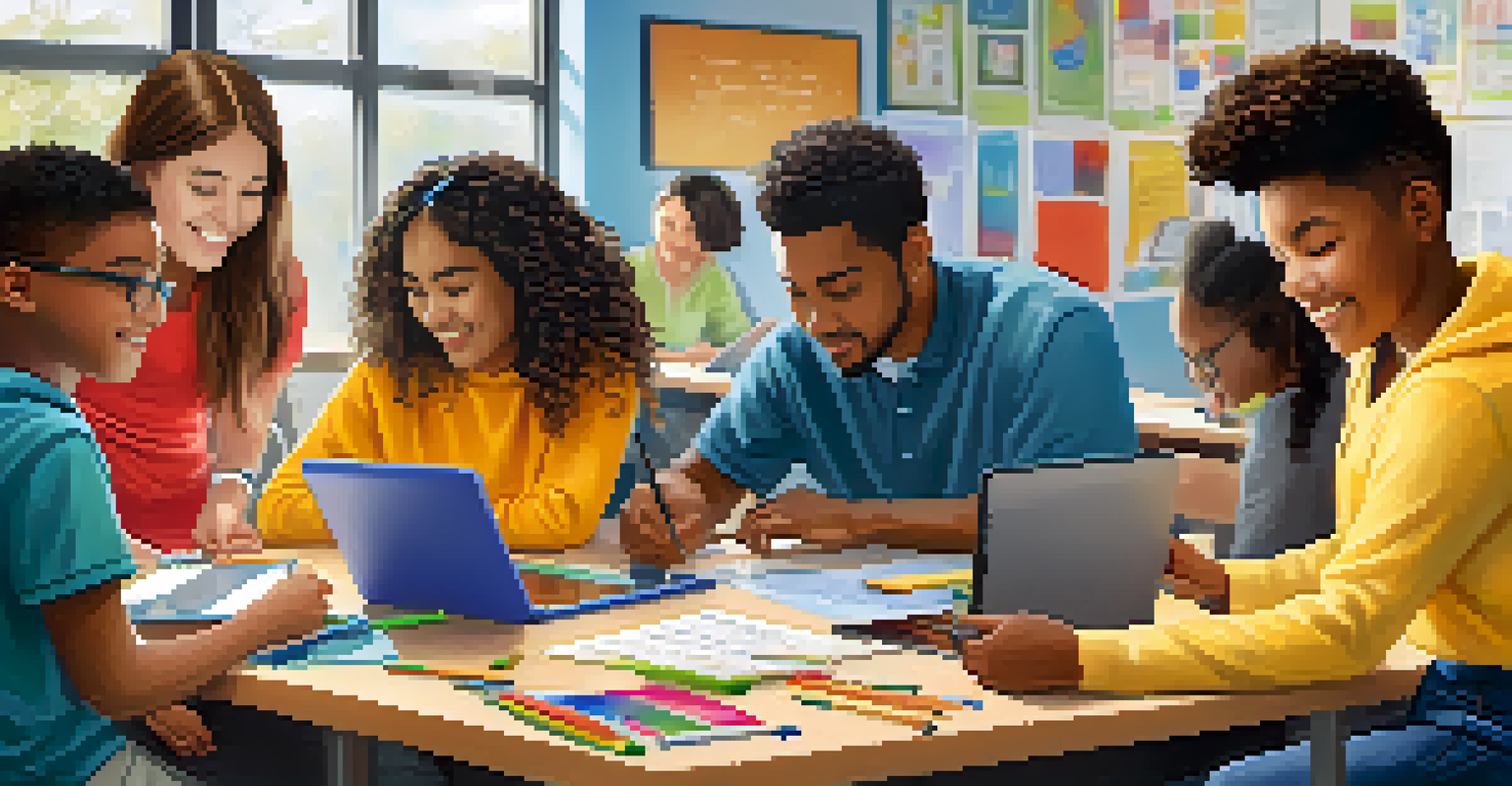The Impact of Classroom Environment on Learning Processes

Understanding Classroom Environment and Its Elements
The classroom environment encompasses various elements, including physical space, social dynamics, and emotional atmosphere. These factors combine to create a unique setting that can either enhance or hinder learning. Think of it like a garden; the right conditions can lead to blossoming flowers, while neglect can result in a withered landscape. Understanding these elements is the first step toward optimizing a learning experience.
The classroom should be an entrance into the world, not an escape from it.
Physical aspects such as lighting, seating arrangements, and decorations play a crucial role in how students feel and interact. For instance, natural light can boost mood and concentration, while a cluttered space may lead to distraction. By consciously designing these elements, educators can foster a more inviting and effective learning environment. This sets the stage for deeper engagement and better outcomes.
On the other hand, social dynamics within the classroom, including peer relationships and teacher-student interactions, significantly impact learning. A supportive environment encourages collaboration and open communication, making students feel valued and heard. When students feel comfortable sharing their thoughts, they are more likely to participate and take risks in their learning journey.
The Role of Physical Space in Learning
Physical space is a foundational element of the classroom environment that directly affects how students learn. A well-organized classroom can promote focus and efficiency, while a chaotic layout may lead to confusion and distraction. For example, flexible seating arrangements can encourage collaboration among students, enhancing group work and discussion. This adaptability can make a significant difference in how lessons are received.

Moreover, the arrangement of desks and access to resources can impact student engagement. When students can easily access materials, they feel more empowered and motivated to participate in activities. Imagine a science class where students can quickly grab supplies for experiments versus one where they have to wait in line; the difference in engagement is palpable. This accessibility can cultivate a more active learning atmosphere.
Classroom Environment Enhances Learning
A well-designed classroom environment boosts student engagement and promotes effective learning.
Additionally, incorporating elements like plants, art, or comfortable seating can enhance a classroom’s aesthetic and emotional appeal. These touches can create a sense of belonging and comfort, which are essential for effective learning. Just as a cozy reading nook at home invites you to delve into a book, a thoughtfully designed classroom can inspire curiosity and creativity.
Emotional Safety and Its Impact on Learning
Emotional safety is essential in a classroom environment, allowing students to express themselves without fear of judgment. When students feel safe, they are more likely to take academic risks, ask questions, and share ideas. This open atmosphere fosters a sense of community, which can enhance collaboration and learning. It’s like building a sturdy foundation for a house; without it, everything else feels unstable.
Education is not the filling of a pail, but the lighting of a fire.
Creating emotional safety often involves establishing clear guidelines for respectful communication and interaction. Teachers who model empathy and understanding can help create a culture of support among students. For example, activities that promote teamwork and trust can strengthen relationships and create bonds that enhance learning. When students feel they belong, they’re more likely to engage actively.
Furthermore, recognizing and addressing individual emotional needs can significantly impact students’ ability to focus and learn. When students know their feelings are acknowledged and valued, they are more prepared to tackle academic challenges. Picture a classroom where every student feels seen and respected; this foundation can lead to remarkable academic and personal growth.
Social Dynamics and Peer Influence in Learning
Social dynamics within the classroom are pivotal in shaping the learning experience. Peer relationships can encourage or deter student engagement, depending on the prevailing classroom culture. When students collaborate and support one another, they often find motivation in shared goals. Imagine a group of friends studying together; their collective energy can elevate the learning process.
Moreover, the presence of positive role models among peers can inspire students to strive for their best. When students see their classmates succeeding, it often sparks a desire to emulate that success. This healthy competition can lead to greater achievements and a more vibrant learning environment. Conversely, negative influences can stifle participation and enthusiasm.
Emotional Safety Fosters Participation
Creating emotional safety in the classroom encourages students to express themselves and take academic risks.
Teachers can harness these social dynamics by promoting teamwork and cooperative learning strategies. Activities that require collaboration can build trust and foster a sense of belonging. This not only enhances interpersonal skills but also deepens understanding of the material, making learning a communal experience rather than a solitary task.
The Importance of Classroom Management
Effective classroom management is a crucial aspect of creating a productive learning environment. It involves not only maintaining order but also fostering a positive atmosphere where learning can thrive. Think of it as being the conductor of an orchestra; when every instrument is in harmony, the music flows beautifully. A well-managed classroom encourages respect, attentiveness, and engagement.
Establishing clear expectations and routines can significantly alleviate disruptions and enhance focus. When students know what is expected of them, they are more likely to stay on task and engage in learning activities. For example, starting each class with a brief review can set a clear direction and energize students for the day ahead. This predictability can reduce anxiety and foster a sense of security.
Additionally, responsive classroom management that adapts to students' needs can further enhance the learning experience. By being attuned to student emotions and behaviors, teachers can provide the necessary support and adjustments. This flexibility not only helps in maintaining a conducive learning environment but also promotes student well-being and academic success.
Technology and Its Role in Learning Environments
In today’s digital age, technology plays a significant role in shaping classroom environments and learning processes. Tools like interactive whiteboards, tablets, and educational software can enhance engagement and provide diverse learning opportunities. For instance, using gamified learning platforms can make lessons more interactive and enjoyable, encouraging students to participate actively. This integration of technology can transform traditional learning into a dynamic experience.
Moreover, technology facilitates personalized learning, allowing students to progress at their own pace. With access to various online resources, students can explore topics that interest them, deepening their understanding. This autonomy can lead to increased motivation and a sense of ownership over their learning. Imagine a student delving into a subject they’re passionate about online; the excitement can be contagious.
Inclusivity Enriches Learning Experiences
An inclusive classroom values diverse perspectives, enhancing collaboration and overall learning outcomes.
However, it’s vital to balance technology use with traditional teaching methods. Overreliance on screens can lead to disengagement and distractibility. By thoughtfully integrating technology while maintaining interpersonal interactions, educators can create a balanced and enriching learning environment that caters to diverse learning styles.
Creating an Inclusive Classroom for All Learners
An inclusive classroom environment is one where all students feel valued and supported, regardless of their backgrounds or abilities. This inclusivity is essential for fostering a sense of belonging, which greatly impacts learning. Just as a diverse garden thrives with different plants, a classroom benefits from a variety of perspectives and experiences. Embracing this diversity enriches discussions and enhances learning outcomes.
To create an inclusive environment, educators must employ differentiated instruction techniques that cater to individual learning needs. This might include varied teaching methods, materials, and assessment strategies. For example, visual learners may benefit from diagrams, while auditory learners might thrive with discussions or lectures. By recognizing and addressing these differences, teachers can ensure that every student has the opportunity to succeed.

Additionally, fostering open communication and encouraging collaboration among students can enhance inclusivity. Group projects that require diverse skills can help students appreciate each other's strengths and perspectives. When students learn to work together, they not only gain knowledge but also develop empathy and respect for one another, further enriching the classroom environment.